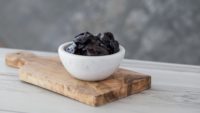In a new scientific review published in Advances in Nutrition titled “The Role of Prunes in Modulating Inflammatory Pathways to Improve Bone Health in Postmenopausal Women,” researchers from Pennsylvania State University examined the relationships between bone health, oxidative stress, inflammation, gut health, and prune consumption. In an analysis and synthesis of more than 18 studies, researchers acknowledge an existing link between prunes and bone health and propose future research to further understand the mechanisms behind the fruit’s positive impacts on bone via suppression of oxidative stress and inflammatory markers, as well as gut microbiota changes.
“Osteoporosis represents a major public health issue with women over 50 years old. Non-pharmaceutical nutritional interventions are becoming increasingly popular, and prunes have been extensively studied as a potential intervention in some populations,” said lead author of the review, Connie J. Rogers, PhD, MPH, Associate Professor of Nutritional Sciences and Physiology, Pennsylvania State University. “There is increasing evidence that the bone protective effects of prunes may be connected to their antioxidant and anti-inflammatory activity, and it is possible that changes to the gut from eating prunes may also be involved in favorable bone outcomes.”
Drawing from both clinical and preclinical trials, researchers suggest that the phenolic compounds and dietary fiber content in prunes may alter the gut microbiome in a manner that decreases the circulation of inflammatory markers, ultimately improving bone turnover. They also propose that the phenolic compounds in prunes may be responsible for antioxidant activity that helps slow the processes involved in bone loss and potentially promotes bone formation.
Clinical trials in postmenopausal women have shown the promising effects of prunes on bone health outcomes, indicating that prune consumption at both 50 grams and 100 grams per day may prevent bone loss. Additionally, research on the relationship between inflammation and prune consumption also suggests prunes’ positive effect on antioxidant capacity and decreases in some inflammatory markers in postmenopausal women with bone loss.
Rogers and her team recommend building on these existing studies by performing larger scale randomized controlled prune consumption trials that include measuring phenolic compounds via blood or urine to further explore changes in oxidation, inflammation and the gut microbiome. In doing so, researchers can more closely and more accurately determine the different pathways prunes may impact in the body and how they lead to improved bone health.
To view the abstract of the review, click here.









